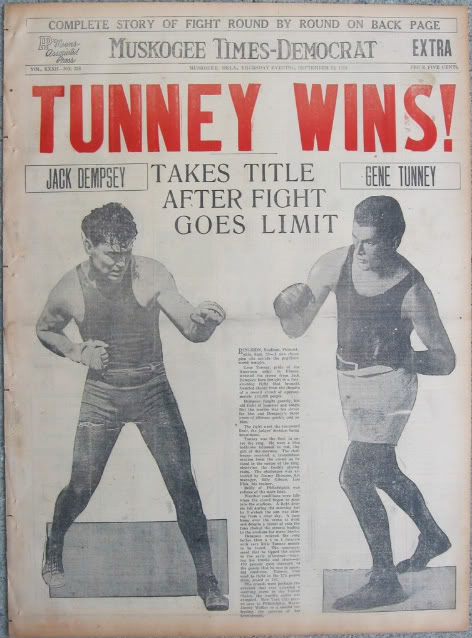Boxing has been part of American culture since the early 1800s. The popularity and notoriety of boxing comes from the legendary characters and fights in its illustrious history. Legendary men such as Floyd “Money” Mayweather, “Sugar” Ray Robinson, Muhammad Ali, “Smoking” Joe Frazier, and Ezzard Charles have produced timeless classics. Bouts such as “the Trilla in Manila” and “Sugar Ray Leonard vs. Roberto Duran II” are a constant reminder of boxing’s grandeur and appeal. However, there was one fight that preceded these and is still as relevant and important as it was when it occurred.1 This bout is known as “The Long Count Fight.” The two characters of this legendary tilt were Jack Dempsey and Gene Tunney.

Dempsey and Tunney were two of the best fighters of the 1920s and each went on to have hall of fame careers. Jack Dempsey was known as the “Manassa Mauler” and was regarded as the people’s champion for his gritty fighting style and charismatic charm. His counterpart, Gene Tunney, was a retired Marine, who was regarded as an intellectual and thus went about boxing with a cerebral and surgical approach.2 These two had met in the ring in September of 1926, and Tunney had been the victor. However, Dempsey was as determined and hungry as ever for another chance to triumph over Tunney. Their rematch the following year would be legendary.
The Long Count Fight was fought on September 22, 1927, and it was fought at Soldier Field in Chicago. Prior to this fight, there had been a new rule implemented that stated that if a combatant was knocked down, the aggressor had to go to a neutral corner before the referee could begin the ten count, which would determine whether the match was over or whether it could resume.3 This rule is what made this fight so controversial.
The first six rounds were going in Tunney’s favor. He was besting Dempsey and the physical toll boxing had taken on Dempsey’s body was beginning to show. It was beginning to look like a repeat of their first encounter. The sixth round was over and the fight was looking like a victory for Tunney; that is, until the fateful seventh round arrived. In the seventh round, Dempsey knocked Tunney down to the mat. However, the referee did not start counting until Dempsey went to a neutral corner, which gave Tunney an extra seven to eight seconds to recover. Dempsey hadn’t been used to the new rule, and as a result, for the rest of that round, Tunney was able to avoided Dempsey. For the rest of the fight, Tunney held his lead on points, even though the crowd showered Tunney with boos for having taken advantage of the long count.4 The crowd also cheered for their man Dempsey until the bitter end. Unfortunately, Tunney was able to avoided Dempsey for the rest of the fight, and eventually won on points. After this fight, one of the greatest heavyweight fighters of all time, Jack Dempsey, retired.
Many believed that the fight had been rigged by way of the referee; others believed that gangsters, such as Al Capone, had influenced the fight.5 In fact, Jack Dempsey once stated “I positively was approached by people in Chicago. I was, in fact, told that for $100,000, I could win the heavyweight championship.”6 Although marred by controversy, neither of those speculations have been definitively proven. But there are many who contend that Dempsey should have been the rightful winner and not Tunney. While the record books will say that Tunney won, it will not be without a metaphorical asterisk. Although Dempsey lost, he was remembered by many as a people’s champion while Tunney was vilified for his role in the match, but still highly respected for his boxing style. Years after this fight, Tunney and Dempsey became close friends and both went on to be boxing Hall of Fame members.7 Both were, are, and forever will be intertwined due to the controversial Long Count Fight.
- Roger Kahn, A Flame of Pure Fire: Jack Dempsey and the Roaring ’20s (New York: Harcourt Brace & Co, 1999), 86. ↵
- Roger Kahn, A Flame of Pure Fire: Jack Dempsey and the Roaring ’20s (New York: Harcourt Brace & Co, 1999), 86. ↵
- Bobby Bearden, “The Time Tunnel: 75th Anniversary of ‘The Long Count,'” Boxing 247, no. 1 (March 2017): 1. ↵
- Roger Kahn, A Flame of Pure Fire: Jack Dempsey and the Roaring ’20s (New York: Harcourt Brace & Co, 1999), 422. ↵
- Bobby Bearden, “The Time Tunnel: 75th Anniversary of ‘The Long Count,'” Boxing 247, no. 1 (March 2017): 1. ↵
- Jack Dempsey, “In This Corner,” Saturday Evening Post 204, no. 9 (August 29, 1931): 25–38. ↵
- Roger Kahn, A Flame of Pure Fire: Jack Dempsey and the Roaring ’20s (New York: Harcourt Brace & Co, 1999), 422. ↵



65 comments
Isaac Rodriguez
Prior to reading the article, I did not know that boxing was part of the American culture since the 1800’s. It surprises me that Jack Dempsey was approached by someone who could likely rig the fight. Knowing that $100,000 was a lot of money nearly 100 years ago, I looked into how much money that would be today. According to an inflation calculator, in 1926 $100,000 would be over 1.4 million with today’s inflation rate.
Timothy ODekirk
This article was by far one of the most interesting that I have read for this week so far. Boxing, has to be one of my favorite sports to watch. It’s just so much fun and engaging, even if I watch it on TV with some friends. I am also a huge fan of boxing movies, such as “Rocky” and have been a fan ever since I saw it. The fight between Dempsey and Tunney was extremely entertaining for me. The way it was described in the article was well done. Even though I never heard of this extremely controversial fight before, it is absolutely a topic that I might do some further research on, to the intrigue factor that it has on me.
Rafael Lopez-Rodriguez
This fight I believe is rarely mentioned when we speak of boxing. When a big fight is about to happen people get anxious and buy the paper view and invite their friends and family to watch the big fight. It was interesting to read about this fight. Maybe people will have this fight in their conversations when watching rematch matches of big name boxers like Floyd Mayweather and Manny Paquiao. Very interesting article for boxing fans!
Miranda Alamilla
I have personally never heard of this fight; probably because it wasn’t until a few years that I even started paying attention to boxing. It’s interesting, though, to read how to boxers, who are both great at their craft, fought for a championship during a huge change in the game. I understand the controversy on both sides, Dempsey was not used to the new rule, so when he knocked Tunney to the ground, he probably expected to win. However, with the new rule in place, in gave Tunney the advantage to get up and keep fighting. My favorite part of this article was reading that after some time had passed, the two boxers became close friends and Hall of Fame members.
Jasmine Jaramillo
Rematches are always big in boxing. A chance for the people’s champion to redeem themselves is always something that the fans love to see. This article was interesting to read because of the controversy that Jack Dempsey experienced. I feel sort of bad that he wasn’t used to the new rule that was emplaced that was supposed to make him go to a neutral corner. I wonder if there really would have been a different outcome if the referee counted Gene Tunney as soon as he was on the ground. However, I think Tunney put up a tough fight to hold himself up until the seventh round and then keep his points over Dempsey for the rest of the fight.
Thomas Fraire
I have never really been a huge fan of boxing or understood all the rule in the sport or anything I had read in the past on it. This story was really cool, it crazy that someone rigged the fight and the ref took so long to start his count. Overal this is a great article though I enjoyed it and it had an excellent tale.
Ashley Tumlinson
As a boxing fan, this article was a truly intriguing read! I love how you took both the historical history and the recreative position within the overall telling of your story. The concept grasped was a street fighter vs. a by the boy technical fighter and it flowed throughout! It was really interesting that Tunney won solely based on the gathering of points! Simultaneously it is interesting how affiliated he was with gang violence and how he was more known for what he did on the street versus what he did in the ring!
Clarissa Bustamante
This was such an interesting article. By reading it, it was easy to recognize that there was a lot of controversy in this specific boxing match. When it comes to sports and huge competitions like these it is very irritating and disappointing how there are times when the opponent discovers rules that can be used and incorporated in to their game plan. like in this article his opponent was avoiding him in order to not get beat out, which is upsetting to an athlete who doesn’t get the opportunity to show or put to work their skills.
Osman Rodriguez
Very interesting article, especially coming off of two big boxing fights these past 2 months. I had never heard of this Long Count Fight before, nor had I heard about these two fighters. I also didn’t know that the 10 count rule was one that was implemented rather than being there from the start of the sport. Seeing as to how you put it in the article, I too believe Dempsey won, and would blame it on the ref. I would argue it was the ref’s job to tell or direct Dempsey to his corner.
Karina Nanez
Interesting that such a fight would have had such controversy surrounding it. I myself am not a big fan of boxing nor do I follow the sport, but the dedication these men must have put into their career to be considered such great fighters is unimaginable. I cannot even begin to imagine how frustrating it was for Dempsey and his fans that Tunney won after taking advantage of a new rule and avoiding him most of the match.